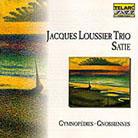January 1999
Think freely also applies in spades to Jacques Loussier. Where people with lesser imagination only see dust, sand dunes, craggy rocks and formidable obstacles, visionary archeologists dig for lost cities and find them. Loussier recognized swing and syncopation hidden in J. S. Bach’s well-tempered piano fugues where clearly what the scores dictate is mathematical, nearly mechanical precision to render intelligible their awesome thematic complexity. His ground-breaking Plays Bach [Telarc CD-83411] rewrote all rules and introduced entranced audiences to a Johann Sebastian who had tossed the orderly composure of coifed wig and rosy cheeks. J.S. emerged from Loussier’s study with a half-smoked Gitan dangling from a three-day stubbled face behind way-cool shades and unruly hair and laid down one rollicking and funky groove after another, ably aided by drums and double bass. With Satie Loussier leaves behind the white-water technique of Plays Bach and meanders down a much calmer, moodier stream. At times barely moving, we simply float suspended. The color is a pale greyish blue, and we’re weightlessly drifting within the glistening depths of the still waters that are the domain of Satie’s Gnossiennes and Gymnopedie No.1. The original, much-beloved scores are surrealistic and very pure piano meditations, short on excess but rich in subtlety, pointing in their minimalism towards the later Milhaud, John Cage, Steve Reich and Philip Glass. They surprise with harmonic twists and non-standard scales from which the Jacques Loussier Trio fashions a set of relaxed, introverted jazz numbers. Perfect for twilight listening when day and night co-exist and doors to other dimensions briefly open, Loussier’s Satie combines abstraction and emotionalism in an uncanny balance. Neither heady like certain jazz is wont to be nor romantic in an excessive way, this disc rides down silvery moon rays, visits submerged realms of elfin kings and mermaid courts and somehow arrests time in a slightly outside sort of way. Gymnopedie No.1 is how we first dip our toes into these currents, and we will revisit this tune three more times as the Trio embarks on distinct variations and takes of this arguably most famous and easily recognizable slow-waltzing Satie piece. Loussier’s first variation stays close to the familiar pastoral theme, which was inspired by the classical Greek anapale dance. His second take goes more up-tempo and shortens the original’s three-beat pattern to a shifty two-beat, venturing further outside, with Benoit Dunoyer de Segonzac’s bass upholding the melodic line in the end while the piano bops through fragmented scat runs. Gnossienne No.3 follows with its circular motif and unusual descending harmonic progression, which adds a deeper tinge of blue, bitter-sweet memories of water nymphs glimpsed once and never forgotten. Gnossienne No.6 opens with a repetitive rock-derivative bass line, while the piano pursues the melodic theme on different levels and keys, with intervals of monotone parallel lines between bass and piano that allow drummer André Arpino’s feathered brushes to explore rhythmic accents. Gnossienne No.2 opens with solo bass plucking, stringing together in seeming disarray thematic fragments which the piano reassembles into an atmospheric collage. The mood is of walking down long, dim corridors which repeatedly open to the outside for brief glances of changing scenery, alternating monochrome half-light with a more colorful but still-muted spectrum. Gymnopedie No.1 returns in its third incarnation, again based on an even beat, which frees the plaintive melody from its original moorings. Syncopated bass and warm drums provide the regulated underpinning over which Loussier alternates melody with stylistic embellishment while his left hand provides the soft chordal drone. Gnossienne No.4’s opening triplet arpeggios anchor the rhythmic pulse until the ensemble brakes away into a freer section where only the brushes maintain the original triplet accompaniment until, after a zero-gravity drum solo, the piano once again returns us to ground with the familiar melody and its minor chord structure. Gnossienne No.5 begins as a stately dance complete with curtsies and then morphs into a moderately driven jazz improv with odd-beat drum accents and bouncy bass lines, and eventually returns full-circle to the opening tune. Gymnopedie No.1‘s fourth variation employs more thematic entfremdung of the source material while maintaining its misty mood, and Gnossienne No.1 is, for a few periods, a very contemporary jazz take that wouldn’t be out of place in a café or chess house except for the disjointed interludes that pull the rug out from conventional grooves. The album closes with a solo piano number, Pas à pas, which allows Loussier’s tremendous abilities as a pianist and composer to shine, grabbing handfuls of dense chords interspersed with broken fast-fingered runs while traversing through different keys, always returning to Satie’s melodic motif to anchor his free associations. Think freely, buy this disc, and watch it turn into a classic. The superior Telarc sonics are an added bonus, or boon, to stay with the magical flair of this music. GO BACK TO: |
 Jacques Loussier Trio - Satie
Jacques Loussier Trio - Satie![[Reviewed on CD]](../format/regcd.gif) "Ouvrez
la tête" -- think freely. This handwritten comment that Erik Satie
affixed to one of his solo piano miniatures declares the frame of mind he wanted expressed
by the performer. It also describes himself, a cast-out bohemian of uncompromising
originality whose chaotic existence amidst the dubious morals of fin-de-siècle
Montmartre left him on the outskirts of public recognition. Where his famous
contemporaries Debussy and Chabrier drew straight and bold lines in the sand, his own life
line was far more eccentric and obscure.
"Ouvrez
la tête" -- think freely. This handwritten comment that Erik Satie
affixed to one of his solo piano miniatures declares the frame of mind he wanted expressed
by the performer. It also describes himself, a cast-out bohemian of uncompromising
originality whose chaotic existence amidst the dubious morals of fin-de-siècle
Montmartre left him on the outskirts of public recognition. Where his famous
contemporaries Debussy and Chabrier drew straight and bold lines in the sand, his own life
line was far more eccentric and obscure.